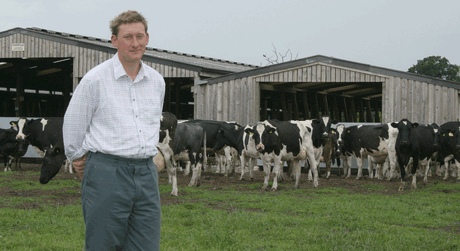Why a Staffs farm chose timber for cow housing

Cow accommodation is crucial to herd welfare and productivity and with increasing herd and cow size, replacement is top of the agenda for many farms.
Wet slurry and wood might not appear to be the most durable of combinations, yet timber uprights in wooden dairy cow accommodation will withstand the corrosive impact of slurry better than steel, says Staffordshire farmer Richard Kennerley.
It’s a fact he was well aware of when he decided to replace ageing cow kennels with a new timber building for his 150 cows. But it was only one of several reasons why he made the decision.
“Timber was always our preferred choice for the new cow building and the environment it has created for cows must be just about ideal. Cow welfare is a high priority for us and the wooden construction helps us achieve the standard of accommodation and cow comfort we want,” says Mr Kennerley.
Plum Tree Farm, Somerford Booths, Congleton, comprises 36ha (90 acres) of owned land and 26ha (65 acres) of adjoining rented land plus a 9ha (23-acre) block that is rented nine miles away and used for maize.
The herd’s expansion hit the worst of the milk price slump but, with extra cows bought before prices took off and now settled into the system – which is now run as a flying herd – and the new building and parlour installed, Mr Kennerley is convinced he was right to stay with timber cow housing.
“My father created the dairy unit here from scratch 35 years ago and put up timber cow kennels, so I was well aware of the durability of wood even though people think timber and slurry is a fatal combination,” he says.
He sums up the environment created by timber quite simply: “Cows are comfortable and contented and that’s a pretty good basis for profitable milk production.”

Over-stocked cow kennels, an inadequate self-feed silage system and the need to replace a 6:8 abreast parlour drove the decision to expand. But it was always going to be a timber cow house.
“We wanted the system to be as flexible and as simple as possible and to switch to a central feed passage instead of a self-feed system,” says Mr Kennerly.
The final design of the Farmplus building – which cost about £1100 a cow place – centred around 75 cubicles down each side with an adjoining parlour and holding yard.
Slurry is scraped into a channel at the end of the building, passages are 4.25m wide. The building, with a cement fibre roof, is almost 52m (170ft) long by 33.5m (110ft) wide.
The part Yorkshire-boarded sides provide adequate ventilation along with the building’s open ends.
There are open ridges above the cow beds and a covered ridge over the feed passage.
Cubicles are 2.4m x 1.2m (8ft x 4ft) with a slanted bottom rail to aid lunging room. The 12:24 parlour has the option for further expansion and has the herd milked in just under two hours.
“We tried paper waste in the beds initially, but had problems with the beds going too hard in the second winter, so we’ve switched to sand and top up the beds every three weeks.”
When Mr Kennerley looks out across the yard he can still see the 35-year-old wooden cow kennels. “They are a great advert for timber.
They don’t meet our design and capacity needs for modern dairy farming, but the only real deterioration has been the tin roof, not the timber structure. The heel boards have fallen off, but it’s not the wood that rotted, it’s the nails that have corroded.”
Herd average is about 7800kg based on a forage ration of two-thirds grass and one-third maize with 3kg of a blend in the mix. Cows are fed concentrates to yield in the parlour up to a maximum of 9kg. In midsummer cows were giving about 16 litres off grass, with staler milkers yielding 19-20 litres.
But while Richard Kennerley is convinced his timber cow building provides a near perfect environment for dairy cows, his herd will be spending less time under cover in future.
Investment in an infrastructure of paddocks and tracks will enable the new paddock grazing system to carry grass for longer into winter and, hopefully, provide an early bite for cows at the beginning of February.
“We’re keeping to a strict rotational grazing programme, with cows staying in paddocks for one or one-and-a-half days and closely monitoring grass growth.”
Housing cows in a timber building is providing the constant environment that Mr Kennerley feels can’t be so easily achieved with steel and concrete.
“We aren’t pushing cows hard, although they’ve put on an average of 400 litres since we moved into the new house. The old cow kennels are now used for dry cows, but there’s is no longer any youngstock on the farm.
“We decided to switch to a flying herd and have a regular supplier of calved heifers. We order what we want a year ahead, so the rearer knows what we need. Heifers arrive about three weeks before calving.
“It’s not only more convenient for us not to have youngstock on the farm, but in cost terms it’s proving to be a big saving.”
Wooden cow accommodation
- Durability
- Flexible bedding options
- Improved cow comfort
